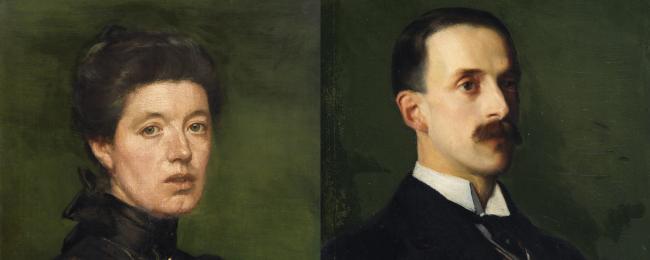
Letters
This collection comprises over 450 letters from, art dealer and collector, Hugh Lane to, artist and social reformer, Sarah Cecilia Harrison between 1905 and 1915, as well as a selection of documents relating to Harrisson's claim that Lane’s last will and testament was fraudulent, after his unexpected death in 1915. This rich resource provides insight into the lives of these two friends who were at the centre of some of the social and cultural developments taking place in Dublin, in the early twentieth century. Across hundreds of hand-written pages, Lane discusses many different aspects of their professional and personal lives, as well as documenting their combined efforts to establish a gallery of Modern art in Dublin.
Lane's letters express a strong sense of his personality through his many anecdotes and descriptions of his achievements and disappointments. A result of reading only one side of their correspondence, however, is the absence of Harrison's voice in their ongoing conversation. Aspects of her life and work are present, nonetheless, and elements of her character shine through her good friend's words. Lane's many observations on Harrisson's work as a city councillor and his admiration for her portrait practice, present a picture of a complex women who contributed significantly to Dublin's social and cultural life.
The Municipal Gallery of Modern Art
Lane's ambition to establish a municipal gallery of modern art in Dublin (now the Hugh Lane Gallery) was not one achieved easily. A lack of art for the gallery’s walls was not the issue, with Lane promising to gift the nucleus of a collection to the gallery. This included works by leading European artists including Claude Monet and Augustus John, as well as Irish artists such as Walter Osborne and Sarah Purser. Lane offered his gift on the condition that a purpose-built gallery would be available and free of charge to the public. A lack of funding and political interest remained obstacles to Lane’s progress. Nevertheless, the first iteration of the gallery opened at 17 Harcourt Street, in 1908. The location was, according to Lane, a fire hazard and too small to house the collections. Furthermore, Lane could not access the public funds promised by Dublin City Council and by 1909 it seemed like the gallery was destined to close. Letters from Richard Caulfield Orpen to Harrison indicate the severity of the issue, while Harrison writes of loaning £400 to keep the gallery open. In 1910, Parliament finally passed a library bill amendment that allowed the Gallery to access the funds it required to remain open.
When he talks about the extravagance of spending 43,000 on a building & then goes on to talk of the poverty of Dublin people. Why is it not more insisted on that the spending of this money will be giving it to these poor workmen
Hugh Lane to Sarah Cecilia Harrison, 1913
Harrison and Lane worked together to promote the gallery and Lane's letters document his communications with Irish newspapers seeking opportunities to promote pictures he had bought to add to his gift. Harrison provided Lane, who lived in London, with regular updates on progress with the gallery and responded to his requests that she write critiques of the new pictures.
Lane had his eye on St Stephen’s Green as a permanent location for the gallery and wanted architect Edwin Lutyens to design a new building within the grounds of the park. Although Lutyens agreed, Lord Ardilaun, who had gifted the park to the city in 1880, did not. Lane expressed his frustration and growing dislike for Ardiluan in his letters to Harrison. Lane's subsequent idea was to build the gallery on a bridge spanning the river Liffey, though he acknowledged the enormous cost of this proposal during a time of deep economic decline. Despite the best efforts of Lady Gregory to raise funds in the United States of America and Lane’s suggestion that the project would provide employment for people out of work, he communicated his disappointment of the plan's failure to Harrisson in 1913.
Artist and Art Dealer
Lane was a successful art dealer with an interest in both Old Master paintings and modern European art. He also sought to promote modern Irish artists. In his letters to Harrison, he writes fondly of the ‘Laverys’ and the ‘Corots’ he has bought, or the ‘Watts’ he wishes to borrow to show in an exhibition. For Lane, art was a profession, but it was also something he loved passionately, expressing his desire and ways to share his collection with other people regularly.
Harrison had a diverse career as an accomplished portraitist, the first female city councillor and a suffragist. She worked for social reform and projects that aimed to alleviate poverty in Dublin. It is clear from Lane's letters that Harrison had great determination and worked hard to accomplish her goals. He also writes of her skillful portraits and encouraged her to put more time into her painting. It seems that Lane did not grasp fully the reasons for Harrison’s social and political work and while he contributed money to her charities, he also advised her to rest and to take breaks.
Socialite
In many of his letters to Harrison, Lane discussed mutual friends or invited Harrison to exhibitions and lunches. Among the many names that appear in his letters are friends such as William Orpen, Sarah Purser, George Moore, George Russell, John Shaw Taylor, Lord and Lady Drogheda, Colonel Poe and Richard Caulfield Orpen. Lane had an active social life that revolved around his work as an art dealer and curator. He wrote regularly of his meetings with potential clients and parties that he organised to introduce collectors who might loan works of art for exhibitions.
Lane travelled regularly and wrote of daytrips in England and Ireland or sent postcards from European cities. On one occasion, he advised the hard-working Harrison to take a much-needed break and a real holiday!
Ciara O'Brien, ESB CSIA Assistant Archivist
Published online: 2022